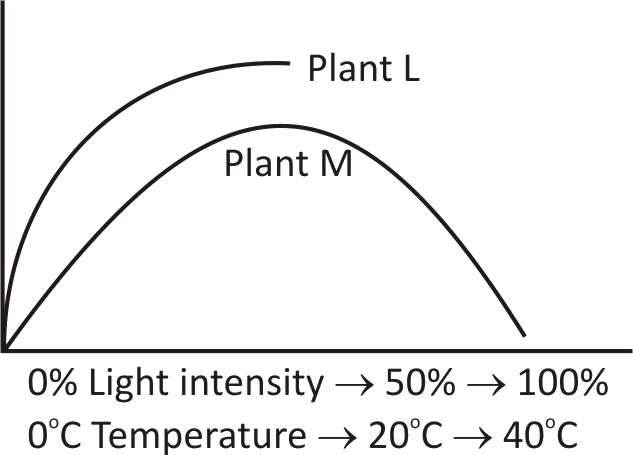
When two plants L and M were exposed to different light intensities and temperatures, they showed changes in their rates of photosynthesis, which have been represented in the following graph.
The graph indicates that.

A- Plant L is a
B- Plant M is a
C- Plant M is a
D- Plant L is a plant and can not function at light intensities above the saturation point.

Answer
482.1k+ views
Hint: Rate of photosynthesis is greater in intense light than diffuse light . But a higher light intensity the process of photooxidation occurs and photosynthesis apparatus may get destroyed.
Complete answer:
When a plant can achieve maximum rate of photosynthesis at light intensity that is known as light saturation point. In
Additional information:
Factors affecting photosynthesis:
1.Light quality and wavelength: maximum photosynthesis takes place in red light than in blue light.
2.Light intensity: rate of photosynthesis is greater in intense light than diffuse light
3.Temperature: Optimum temperature for photosynthesis is 20-35°C
4.Water : The rate of photosynthesis reduces due to lack of water
5.Inhibitors: All the chemicals are used as herbicides which mostly block electron transport system
6.Minerals:For the structure of chlorophyll and enzymes magnesium and nitrogen are essential.
Note: Compensation point is very low in
Complete answer:
When a plant can achieve maximum rate of photosynthesis at light intensity that is known as light saturation point. In
Additional information:
Factors affecting photosynthesis:
1.Light quality and wavelength: maximum photosynthesis takes place in red light than in blue light.
2.Light intensity: rate of photosynthesis is greater in intense light than diffuse light
3.Temperature: Optimum temperature for photosynthesis is 20-35°C
4.Water : The rate of photosynthesis reduces due to lack of water
5.Inhibitors: All the chemicals are used as herbicides which mostly block electron transport system
6.Minerals:For the structure of chlorophyll and enzymes magnesium and nitrogen are essential.
Note: Compensation point is very low in
Recently Updated Pages
Master Class 11 Economics: Engaging Questions & Answers for Success

Master Class 11 Business Studies: Engaging Questions & Answers for Success

Master Class 11 Accountancy: Engaging Questions & Answers for Success

Master Class 11 English: Engaging Questions & Answers for Success

Master Class 11 Computer Science: Engaging Questions & Answers for Success

Master Class 11 Maths: Engaging Questions & Answers for Success

Trending doubts
State and prove Bernoullis theorem class 11 physics CBSE

1 ton equals to A 100 kg B 1000 kg C 10 kg D 10000 class 11 physics CBSE

State the laws of reflection of light

One Metric ton is equal to kg A 10000 B 1000 C 100 class 11 physics CBSE

1 Quintal is equal to a 110 kg b 10 kg c 100kg d 1000 class 11 physics CBSE

Difference Between Prokaryotic Cells and Eukaryotic Cells




